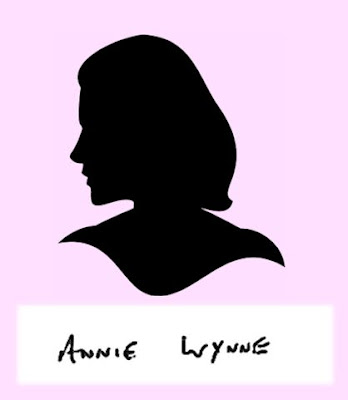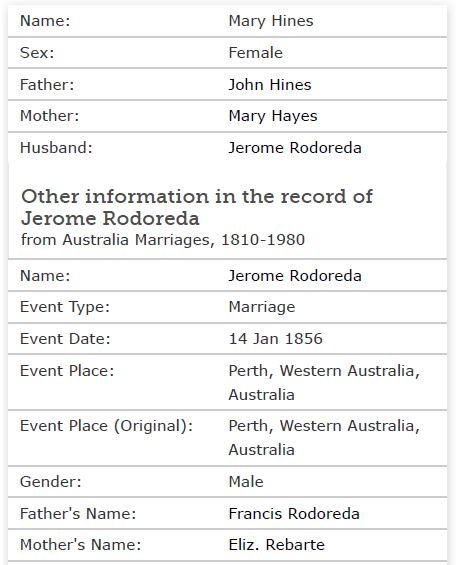
So,
if my suspicions are correct, Mary Anne Hynes arrived in Western Australia, unexpectedly, on 24 March 1854, and realised she had no way of getting to Melbourne. What did she do then? Did she know someone in Perth? Probably not! Did she stay in an immigration depot while she looked for a job? How long was she looking for work? And, how did she support herself in the 21 months before she married Geronimo (Jerome) Rodoreda?Too many questions, with no good answers. One online family tree suggests, she worked as a milliner before her marriage, not in domestic service. Maybe the copy of her civil marriage register will shed some light on this, if it ever arrives. But, no further evidence of her occupation has been uncovered.
Geronimo Rodoreda (given name anglicised as Jerome, in Perth) Jerome Rodoreda, Mary Anne's future husband, was born in Barcelona, Spain. He became a panadero (i.e. a baker). Later he joined the Benedictine missionaries with a view to bringing Christianity to the Australian Aborigines. On 6 October 1849, he left Cádiz in Spain aboard the Spanish man-of-war
La Ferrolana, with 39 other religious and lay missionaries. The frigate docked in Fremantle, Western Australia, on 29 December 1849 and the missionaries soon made their way to the Victoria Plains, where they were based.
 |
Missionaries on La Ferrolana, Cádiz to Western Australia, 1849
|
On 15 November 1855, two months before his marriage, Jerome Rodoreda took over Mr. William Dalton's bakery in Perth. Having left the missions, he baked bread and cakes for the people of Perth for over 30 years.
Jerome and Mary Anne, both Roman Catholics, celebrated their marriage on 14 January 1856, at a Mass said by Venantius Garrido, one of the Spanish priests who travelled with Jerome from Cádiz. Jerome's best man was Juan Perejuan, who also arrived in Western Australia on
La Ferrolana. Mary Anne's bridesmaid, Ann Maria Farmer, was Juan Perejuan's wife, not someone Mary Anne knew from home.
The couple had nine children recorded in the baptism registers of the Cathedral of St John the Evangelist and the Church of the Immaculate Conception of the Blessed Virgin Mary (St Mary's Cathedral), in Perth.
- Isabella Mary Rodoreda, born to Geronimo Rodoreda and Mary Anne Hynes on 8 July 1857, was baptised on 12 September 1857, by Martin Griver, also a Spanish priest who arrived in Perth on La Ferrolana. Isabella's Godmother was Catherine Sheehy, the daughter of Terent and Virginia Sheehy. Isabella never married. In later life, she suffered mental health issues. She died from pulmonary tuberculosis, on 30 September 1909, as a state patient at the Yarra Bend Hospital for the Insane, near Melbourne. Her remains are buried in the Boroondara General Cemetery in Kew, Victoria, beside her father who died the following year.
- Christina Mary Teresa Rodoreda, born to Geronimo Rodoreda and Mary Anne Hynes on 26 February 1859, was baptised by Martin Griver on 26 March 1859. Christina's Godmother was Mary Hynes, daughter of George and Catherine Hynes. Mary Hynes was of no known relation, but travelled to Perth on the same ship as Mary Anne. Christina never married either. She died on 30 June 1938 and was buried in the Roman Catholic Cemetery at Karrakatta, in Perth.
- Francis Edward (aka Francis Edgeworth), born to Geronimo Rodoreda and Mary Anne Hynes on 12 September 1861, was baptised by Martin Griver on 11 October 1861. Francis' Godmother was Sara Campbell, daughter of George and Sara Campbell. Francis became a baker like his father. He married Margaret O'Mara in 1887 and they had three surviving sons and a daughter. Francis died in West Perth on 11 November 1939 and was buried at the Cemetery in Karrakatta.
 |
Baptism register, Franciscus Rodoreda, 1861
|
- Twins, Margaret and Mary Rodoreda, born to Geronimo Rodoreda and Mary Anne Hynes on 15 November 1862, were baptised by Martin Griver the following day. Their Godparents were Joseph and Ellen Reilly. Both infants died within about six weeks, first Margaret, then Mary. It is likely they were buried in the East Perth Cemetery. Perhaps they share a grave with Mary Anne, who died on 5 November 1881.
- Edward John Rodoreda, born to Geronimo and Mary Anne Rodoreda on 9 January 1864, was baptised by Anselm Bourke on 15 January 1864. Edward's Godparents were Isidor Oriel and Mary Anne Kenny. Edward became an auctioneer and a land and estate agent. He married Julia Down in 1891 and the couple had 15 children, 11 of whom reached adulthood. Edward died in Melbourne on 6 February 1928, following an operation at St Benedict's Hospital, and was buried at Springvale Botanical Cemetery in Melbourne.
 |
| Baptism register, Eduardus Rodereda, 1864, Perth |
- Joseph John Rodoreda, born to Jerome and Mary Anne Rodoreda on 7 May 1865, was baptised by Mat Gibney on 14 May 1865. Joseph's Godparent's were Ignatius and Mary Boladeras. Ignatius was one of the former Spanish missionaries that came to Western Australia with Jerome. No further information has been discovered concerning Joseph, who may have died in childhood.
- Charles Dolphus Rodoreda, born to Jerome Rodoreda and Mary Anne Hines on 3 January 1867, was baptised by Mat Gibney three days later. His Godmother was Helen (or maybe Ellen) Reilly. In May 1889, Charles took over his father's bakery business in Howick Street and opened a grocery store at Beaufort Street. In December that year he sold the bakery business to an established baker, with a view to concentrating on his grocery interests. Charles married Sarah Darch in 1892. The couple had three surviving sons. Charles died on 18 July 1942 and was buried at the Karrakatta Cemetery.
 |
| The Daily News, 11 May 1889, p. 4 |
- Agnes Mary Rodoreda, born to Geronimo Rodoreda and Mary Anne 'Ines'
on 19 April 1869, was baptised by Martin Griver on 25 April. Her sister Isabella was her Godmother. Agnes joined the Convent of Mercy and became a nun in December 1890, taking the religious name Sister Mary Alacoque. Sister Alacoque became a very successful music teacher at Our Lady's College, Perth. She died on 5 September 1957, aged 88 years, and was buried at the Karrakatta Cemetery.
I like to think Mary Anne had some communication with 'home' over the years. For example my great-great-grandmother Bridget (Hynes) Wynne, Mary Anne's sister, named a daughter Isabella, in 1863, and a daughter Agnes, in 1877. Isabella was not a common name among Roman Catholics in Ireland then, and Agnes was not that prevalent either. Perhaps Bridget followed Mary Anne's lead. Bridget also had two daughters, Margaret born in 1850 and Mary in 1860. However, these were such common names, little inference could be drawn from her choosing them. Plus, Margaret was the name of Bridget and Mary Anne's mother.
If you are related to anyone mentioned above, I'd love to hear from you: Email blackraven.genealogy[at]gmail.com.
Sources:1. 'Départes des Missionaires',
Annales de la propagation de la foi, v. 22, Society for the Propagation of the Faith (Lyons), January 1850, no. 128,
pp 71-72, written in French, accessed GoogleBooks.
2. Passenger ships arriving in Australian ports,
Western Australia 1829-89, Rob Nelson, 2001.
3.
The Perth Gazette and Independent Journal of Politics and News, 30 November 1855. p. 1, accessed on
Trove.
4. Marriage register, Church of the Immaculate Conception in Perth, Rodoreda-Hines marriage, 1856, Catholic Archdiocese of Perth Archives.
5. Baptism registers, Church of the Immaculate Conception in Perth, '
Catholic church records of Perth, 1844-1967', Baptisms, 1844-1899, 547 unindexed images, Isabella image 80; Christina image 88 and 89; Francis image 106; Margaret and Mary image 112; Edward image 120; Joseph image 127; Charles image 147; Agnes image 166, FamilySearch.
5. Isabella Mary Rodoreda, 1 October 1909, 'Inquest Deposition Files, 1840-1925', Victoria, Australia, database with images,
FamilySearch.
6. Isabella Rodoreda, 2 October 1909, Boroondara General Cemetery,
Kew Cemetery Grave Archive.
6. Burial records,
Metropolitan Cemeteries Board, Christina Rodoreda; Francis Rodoreda; Charles Dolphus Rodoreda; Agnes Rodoreda.
7. Marriage index, Rodoreda-Omara, 1887, Department of Justice, Registry of Births, Deaths & Marriages,
Register of online indexes.
8. Death notice, Edward John Rodoreda,
The West Australian, 10 February 1928, p. 1, accessed Trove; Burial records,
Southern Metropolitan Cemeteries Trust, Edward John Rodoreda.
9.
The Daily News, 11 May 1889, p. 4;
The Daily News, 20 May 1889, p. 2;
The West Australia, 24 December 1889, p. 2, accessed Trove.
10. Family Notices, Rodoreda-Darch,
The West Australian, 9 May 1892, p. 1, accessed Trove.
Further articles about Mary Anne (Hynes) Rodoreda:-





































